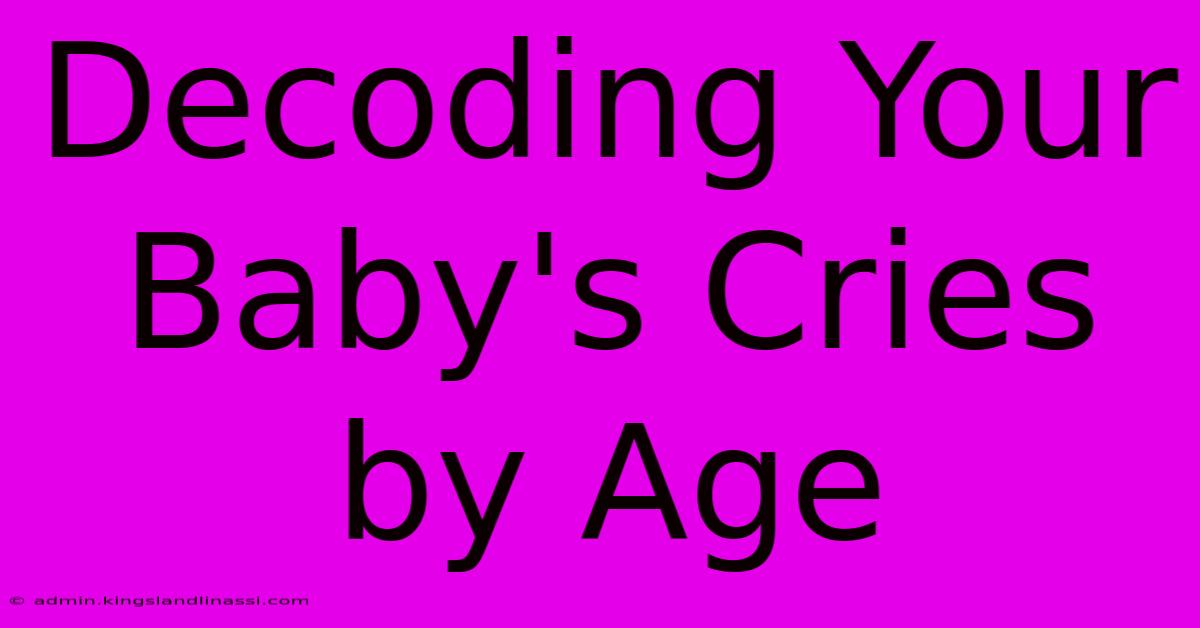Decoding Your Baby's Cries By Age

Table of Contents
Decoding Your Baby's Cries by Age: A Parent's Guide
New parents often feel overwhelmed by their baby's cries. It's a universal experience, but deciphering the meaning behind those wails can feel like learning a new language. This guide will help you understand your baby's cries better by exploring the common reasons for crying at different ages. While there's no magic formula, understanding age-related cues can significantly improve your ability to respond effectively and soothe your little one.
Understanding the Basics of Baby Cries
Before diving into age-specific cries, it's crucial to grasp the fundamental types of cries. While babies cry for various reasons, their cries often fall into these categories:
- Hunger Cry: This cry usually starts softly and gradually intensifies if unmet. It might involve sucking motions.
- Pain Cry: This is a sudden, loud, and high-pitched cry, often accompanied by arched back and clenched fists.
- Discomfort Cry: This cry is often characterized by whimpering or fussing, indicating discomfort due to wet diapers, being too hot or cold, or needing a burp.
- Tired Cry: This is often a whiny or drowsy cry, and your baby may rub their eyes.
- Attention-Seeking Cry: This cry might be a combination of other cries, becoming louder and more insistent if ignored.
Decoding Cries by Age: A Developmental Perspective
The reasons behind your baby's cries change as they grow and develop. Let's explore the common cries you might encounter at different ages:
0-3 Months: The Newborn Phase
Newborns primarily cry due to basic needs:
- Hunger: This is often the most frequent reason. Look for rooting reflexes (turning their head towards your touch) and sucking motions.
- Dirty Diaper: A wet or soiled diaper can cause significant discomfort.
- Gas/Colic: Colic is characterized by excessive crying for no apparent reason. Gentle massage, tummy time, and warm baths may help.
- Overstimulation: Newborns have sensitive nervous systems. Too much noise or activity can lead to crying.
4-6 Months: Discovering the World
At this stage, your baby is becoming more aware of their surroundings and can express more complex needs:
- Separation Anxiety: Crying when separated from parents is common. Consistent routines and comforting objects can help.
- Teething Pain: Gum discomfort can cause significant fussiness. Teething toys and cool objects can provide relief.
- Exploration Frustration: Babies want to explore but lack the skills. Providing age-appropriate toys and opportunities can help.
7-12 Months: Communicating Intentions
Your baby's cries become more nuanced as their communication skills develop:
- Specific Needs: They might cry to indicate a specific desire, like a toy or a drink. Pay close attention to their gestures and expressions.
- Frustration: They may cry when unable to reach a toy or perform a desired action.
- Fear: Fear of strangers or new situations is common. Gentle reassurance and gradual exposure can help.
Beyond Crying: Reading Other Cues
Remember that crying isn't the only way your baby communicates. Pay close attention to other cues, such as:
- Facial Expressions: Your baby's face can provide valuable clues about their emotions.
- Body Language: Are they tense, relaxed, or arched?
- Vocalizations: Besides crying, notice other sounds like gurgling, cooing, or babbling.
Seeking Professional Help
If you are concerned about your baby's crying, particularly if it's excessive, persistent, or accompanied by other symptoms, it's essential to consult your pediatrician. They can rule out any underlying medical conditions and offer support and guidance.
Conclusion: Patience and Responsiveness are Key
Decoding your baby's cries is a journey, not a destination. It takes time, patience, and practice. By carefully observing your baby's cues and responding sensitively, you'll build a stronger bond and gain a deeper understanding of their needs. Remember, responding promptly to your baby’s cries helps them feel secure and loved. This consistent responsiveness fosters a strong parent-child relationship and contributes to your baby’s healthy emotional development. Trust your instincts and don't hesitate to seek help when needed.

Thank you for visiting our website wich cover about Decoding Your Baby's Cries By Age. We hope the information provided has been useful to you. Feel free to contact us if you have any questions or need further assistance. See you next time and dont miss to bookmark.
Featured Posts
-
Revealed The Age Of Cruz Beckhams Girlfriend
Apr 21, 2025
-
Urgent Appeal Donate To Turkey Earthquake Relief Funds
Apr 21, 2025
-
The Best Vitamins For Your Age And Gender
Apr 21, 2025
-
The Camavinga Son Effect
Apr 21, 2025
-
Gay Dad Band A Story Of Perseverance
Apr 21, 2025
